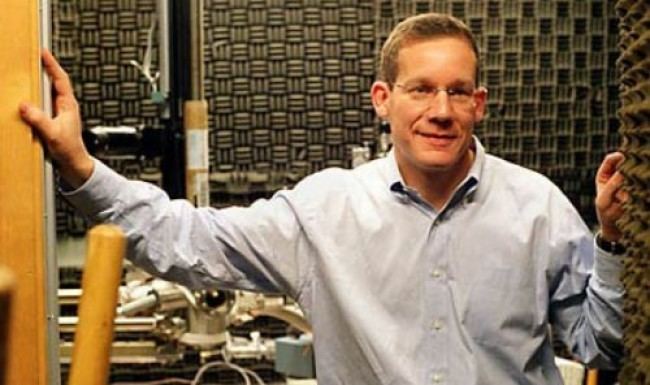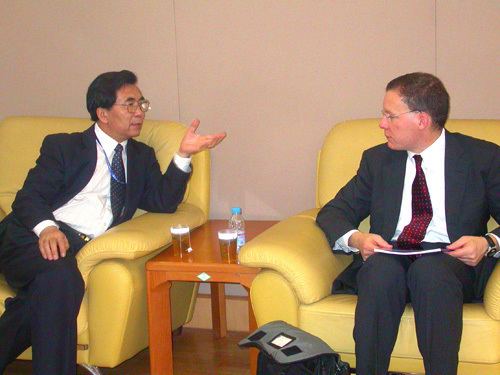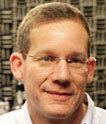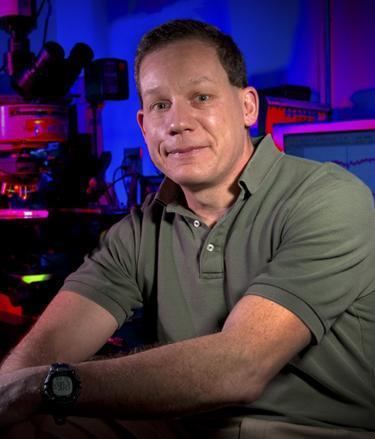Citizenship United States | Role Chemist Name Charles Lieber | |
 | ||
Institutions Harvard UniversityColumbia University Alma mater Franklin & Marshall CollegeStanford University Doctoral students Hongjie DaiPhilip KimPeidong Yang Known for NanoscienceNanotechnology Notable awards ACS Award in Pure Chemistry (1992)Feynman Prize in NanotechnologyWorld Technology Award (2003, 2004)Wolf Prize in Chemistry (2012) Fields Chemistry, Applied Physics Similar People Yi Cui, Peidong Yang, Hongjie Dai, Paul Alivisatos, Philip Kim | ||
Charles M. Lieber (born 1959) is an American chemist and pioneer in the field of nanoscience and nanotechnology. In 2011, Lieber was recognized by Thomson Reuters as the leading chemist in the world based on the impact of his scientific publications. Lieber has published over 380 papers in peer-reviewed scientific journals and has edited and contributed to many books on nanoscience. He is the principal inventor on over fifty issued US patents and applications, and founded the nanotechnology company Nanosys in 2001 and Vista Therapeutics in 2007. He is known for his contributions to the synthesis, assembly and characterization of nanoscale materials and nanodevices, the application of nanoelectronic devices in biology, and as a mentor to numerous leaders in nanoscience.
Contents
- Education and Research Philosophy
- Positions
- Research Achievements
- Current Research
- Awards
- Other Honors and Positions
- Other Interests
- References

Education and Research Philosophy

Lieber “spent much of his childhood building – and breaking – stereos, cars and model airplanes.” He obtained a B.A. in Chemistry from Franklin & Marshall College, graduating with honors in 1981. He went on to earn his doctorate at Stanford University in Chemistry, carrying out research on surface chemistry in the lab of Nathan Lewis, followed by a two year postdoc at Caltech in the lab of Harry Gray on long-distance electron transfer in metalloproteins. A self-confessed competitive person, Lieber feels “pressure to get things done quickly and – ideally – first” and to break new ground: “What I like to do as a scientist is to work on things that have not already been shown to work”. Studying the effects of dimensionality and anisotropy on the properties of quasi-2D planar structures and quasi-1D structures in his early career at Columbia and Harvard led him to become interested in the question of how one could make a one-dimensional wire, and to the epiphany that if a technology were to emerge from nascent work on nanoscale materials “it would require interconnections – exceedingly small, wire-like structures to move information around, move electrons around, and connect devices together.” Lieber was an early proponent of using the fundamental physical advantages of the very small to meld the worlds of optics and electronics and create interfaces between nanoscale materials and biological structures, and “to develop entirely new technologies, technologies we cannot even predict today.”
Positions

Lieber joined the Columbia University Department of Chemistry in 1987, where he was Assistant Professor (1987-1990) and Associate Professor (1990-1991) before moving to Harvard as Full Professor (1992). He now holds a joint appointment at Harvard University in the Department of Chemistry and Chemical Biology and the Harvard Paulson School of Engineering and Applied Sciences, as the Joshua and Beth Friedman University Professor. In 2015 he became Chair of the Department of Chemistry and Chemical Biology.
Research Achievements

Lieber’s contributions to the rational growth, characterization, and applications of a range of functional nanoscale materials and heterostructures have provided concepts central to the bottom-up paradigm of nanoscience. These include rational synthesis of functional nanowire building blocks, characterization of these materials, and demonstration of their application in areas ranging from electronics, computing, photonics, and energy science to biology and medicine.
Nanomaterials synthesis. In his early work Lieber articulated the motivation for pursuing designed growth of nanometer-diameter wires in which composition, size, structure and morphology could be controlled over a wide range, and outlined a general method for the first controlled synthesis of free-standing single-crystal semiconductor nanowires, providing the groundwork for predictable growth of nanowires of virtually any elements and compounds in the periodic table. He proposed and demonstrated a general concept for the growth of nanoscale axial heterostructures and the growth of nanowire superlattices with new photonic and electronic properties, the basis of intensive efforts today in nanowire photonics and electronics. In parallel, he proposed and demonstrated the heterojunction concept of radial core-shell nanowire structures and single-crystalline multi-quantum well structures. Lieber also demonstrated a synthetic methodology to introduce controlled stereocenters – kinks – into nanowires, introducing the possibility of increasingly complex and functional nanostructures for three-dimensional nanodevices.
Nanostructure characterization. Lieber developed applications of scanning probe microscopies that could provide direct experimental measurement of the electrical and mechanical properties of individual carbon nanotubes and nanowires. This work showed that semiconductor nanowires with controlled electrical properties can be synthesized, providing electronically tunable functional nanoscale building blocks for device assembly. Additionally, Lieber invented chemical force microscopy to characterize the chemical properties of materials surfaces with nanometer resolution.
Nanoelectronics and nanophotonics. Lieber has used quantum-confined core/shell nanowire heterostructures to demonstrate ballistic transport, the superconducting proximity effect, and quantum transport. Other examples of functional nanoscale electronic and optoelectronic devices include nanoscale electrically driven lasers using single nanowires as active nanoscale cavities, carbon nanotube nanotweezers, nanotube-based ultrahigh-density electromechanical memory, an all-inorganic fully integrated nanoscale photovoltaic cell and functional logic devices and simple computational circuits using assembled semiconductor nanowires. These concepts led to the integration of nanowires on the Intel roadmap, and their current top-down implementation of these structures.
Nanostructure assembly and computing. Lieber has originated a number of approaches for parallel and scalable of assembly of nanowire and nanotube building blocks. The development of fluidic-directed assembly and subsequent large-scale assembly of electrically addressable parallel and crossed nanowire arrays was cited as one of the Breakthroughs of 2001 by Science. He also developed a lithography-free approach to bridging the macro-to-nano scale gap using modulation-doped semiconductor nanowires. Lieber recently introduced the assembly concept ‘nanocombing,’ which can be used to align nanoscale wires in a deterministic manner independent of material. He used this concept to create a programmable nanowire logic tile and the first stand-alone nanocomputer.
Nanoelectronics for biology and medicine. Lieber demonstrated the first direct electrical detection of proteins, selective electrical sensing of individual viruses and multiplexed detection of cancer marker proteins and tumor enzyme activity. His approach uses electrical signals for high-sensitivity, label-free detection, for use in wireless/remote medical applications. More recently, Lieber demonstrated a general approach to overcome the Debye screening that makes these measurements challenging in physiological conditions, overcoming the limitations of sensing with silicon nanowire field-effect devices and opening the way to their use in diagnostic healthcare applications. Lieber has also developed nanoelectronic devices for cell/tissue electrophysiology, showing that electrical activity and action potential propagation can be recorded from cultured cardiac cells with high resolution. Most recently, Lieber realized 3D nanoscale transistors in which the active transistor is separated from the connections to the outside world. His nanotechnology-enabled 3D cellular probes have shown point-like resolution in detection of single-molecules, intracellular function and even photons.
Current Research
Nanoelectronics and brain science. The development of nanoelectronics-enabled cellular tools underpins Lieber’s views on transforming electrical recording and modulation of neuronal activity in brain science. Examples of this work include the integration of arrays of nanowire transistors with neurons at the scale that the brain is wired biologically, mapping functional activity in acute brain slices with high spatiotemporal resolution and a 3D structure capable of interfacing with complex neural networks. He developed macroporous 3D sensor arrays and synthetic tissue scaffold to mimic the structure of natural tissue, and for the first time generated synthetic tissues that can be innervated in 3D, showing that it is possible to produce interpenetrating 3D electronic-neural networks following cell culture. Lieber’s current work focuses on integrating electronics in a minimally/non-invasive manner within the central nervous system. Most recently, he has demonstrated that this macroporous electronics can be injected by syringe to position devices in a chosen region of the brain. Chronic histology and multiplexed recording studies demonstrate minimal immune response and noninvasive integration of the injectable electronics with neuronal circuitry. Reduced scarring may explain the mesh electronics’ demonstrated recording stability on time scales of up to a year. This concept of electronics integration with the brain as a nanotechnological tool potentially capable of treating neurological and neurodegenerative diseases, stroke and traumatic injury has drawn attention from a number of media sources. Scientific American named injectable electronics one of 2015’s top ten world changing ideas. Chemical & Engineering News called it “the most notable chemistry research advance of 2015.”
Awards
MRS Von Hippel Award (2016); Remsen Award (2016); Nano Research Award, Tsinghua University Press/Springer (2013); IEEE Nanotechnology Pioneer Award (2013); Willard Gibbs Medal Award (2013); Wolf Prize in Chemistry (2012); Fred Kavli Distinguished Lectureship in Nanoscience, Materials Research Society (2010); Friendship Award, People’s Republic of China (2009); Inorganic Nanoscience Award, ACS Division of Inorganic Chemistry (2009); Pioneer Award, National Institutes of Health (2008); Einstein Award, Chinese Academy of Sciences (2008); NBIC Research Excellence Award, University of Pennsylvania (2007); Nanotech Briefs Nano 50 Award (2005); World Technology Award in Materials (2004); ACS Award in the Chemistry of Materials (2004); Scientific American 50 Award in Nanotechnology and Molecular Electronics (2003); Nelson W. Taylor Award, Pennsylvania State University (2003); World Technology Award in Materials (2003); New York Intellectual Property Law Association Inventor of the Year Award (2003); APS James C. McGroddy Prize for New Materials (2003); Harrison Howe Award, University of Rochester (2002); MRS Medal (2002); Foresight Institute Feynman Prize in Nanotechnology (2001); NSF Creativity Award (1996); Leo Hendrik Baekeland Award, American Chemical Society (1995); George Ledlie Prize, Harvard University (1994-1995); MRS Outstanding Young Investigator Award (1993); ACS Award in Pure Chemistry (1992); Denkewalter Prize, Loyola University Chicago (1992); Camille and Henry Dreyfus Teacher-Scholar Award (1990-1995); Wilson Prize (1990); NSF Presidential Young Investigator Award (1988-1993); Distinguished New Faculty Award, Dreyfus Foundation (1987)
Other Honors and Positions
Lieber is an elected member of the National Academy of Sciences, the American Academy of Arts and Sciences, the National Academy of Inventors, and an elected Foreign Member of the Chinese Academy of Sciences (2015). He is an elected Fellow of the Materials Research Society, American Chemical Society (Inaugural Class), Institute of Physics, International Union of Pure and Applied Chemistry, American Association for the Advancement of Science, and World Technology Network, and Honorary Fellow of the Chinese Chemical Society. In addition he belongs to the American Physical Society, Institute of Electrical and Electronics Engineers, International Society for Optical Engineering, Optical Society of America, Biophysical Society and Society for Neuroscience. Lieber is Co-editor of the journal Nano Letters, and serves on the editorial and advisory boards of a number of science and technology journals.
Other Interests
Since 2007 Lieber has grown giant pumpkins in his back yard in Lexington, MA. In 2010 he won the annual weigh-off at Frerich’s Farm in Rhode Island with a 1,610-lb pumpkin, and returned in 2012 with a 1,770-lb pumpkin that won 2nd place in that year’s weigh-off but set a Massachusetts record. His 1,870-lb pumpkin in 2014 was named the largest pumpkin in Massachusetts and ranked 17th largest in the world that year. The discrepancy between the size scales of his day job and hobby has been noted: “…on the one hand, Lieber’s chemistry “has had a defining influence on the field of nanoscience and nanotechnology,” according to his CV. On the other, his pumpkin could probably fill an entire Trader Joe’s with pumpkin specialty products for the fall season.”
